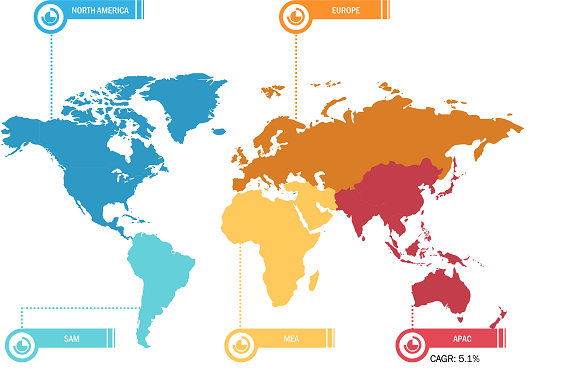Increase in Demand for Convenience or Ready-to-Eat Food to Escalate Chilled Food Packaging Market Growth During 2022–2030
According to our new research study on “Chilled Food Packaging Market Forecast to 2030 – COVID-19 Impact and Global Analysis – by Material, Type, Application, and Geography,” the chilled food packaging market size is expected to grow from US$ 12,948.11 million in 2022 to US$ 18,902.73 million by 2030; it is estimated to register a CAGR of 5.0% from 2023 to 2030. The report highlights key factors driving the chilled food packaging market growth and prominent players along with their developments in the market.
Chilled food packaging refers to the specialized packaging used to store and transport perishable food items that require refrigeration to maintain their freshness and prevent spoilage. It is designed to provide a controlled environment that helps extend the shelf life of chilled food products. The expansion of organized retail and e-commerce is driving the market growth of chilled food packaging market.
Global Chilled Food Packaging Market Breakdown – by Region
Chilled Food Packaging Market Forecast to 2030 - Global Analysis by Material (Plastic, Aluminum, Paper and Paperboard, and Others), Type (Boxes, Tubs and Cups, Cans, Pouches and Bags, and Others), and Application (Dairy Products, Meat and Poultry, Seafood, Fruits and Vegetables, and Others)
Chilled Food Packaging Market Share and Growth by 2030
Download Free Sample
The global chilled food packaging market refers to the packaging of perishable food items that require refrigeration to maintain their quality and freshness. The market includes a range of packaging materials, such as plastic, paper and paperboard, aluminum, and wood, which are designed to keep the food products at a low temperature during transportation and storage. The market is driven by the growing demand for convenience foods, increasing urbanization, and changing lifestyles. The rising awareness of food safety and hygiene is also driving the demand for chilled food packaging. Additionally, the growth of e-commerce and online grocery shopping is expected to fuel the demand for chilled food packaging during the forecast period. New technologies such as high-pressure processing and self-heating packaging for chilled food have led to the expansion of the food packaging industry and expansion of e-commerce and ready-to-eat food is further fueling the chilled food packaging market growth.
Mondi Plc; Amcor Plc; Sealstrip Corp; Sonoco Products Co; Amerplast Ltd; Berry Global Group Inc; Westrock Co; Graphic Packaging Holding Co; Tetra Pak International SA; and Sealed Air Corp are among the key players operating in the global chilled food packaging market. Market players focus on providing high-quality products to fulfill customer demand. They also adopt strategies such as investments in research and development activities and new product launches.
Impact of COVID-19 Pandemic on Chilled Food Packaging Market
The COVID-19 pandemic affected economies and industries in various countries due to lockdowns, travel bans, and business shutdowns. The packaging industry was severely affected by disruptions in supply chains and shutdowns of production plants in the initial phases of the pandemic. The pandemic caused disruptions in the global supply chain due to factory shutdowns, transportation restrictions, and labor shortages. These upheavals affected the availability of raw materials and packaging components, leading to potential supply chain delays and increased operating costs for chilled food packaging manufacturers. The scarcity of raw materials and higher transportation expenses contributed to rising production costs. In addition, the food service sector, including restaurants, cafes, and catering services, experienced a sharp decline in demand because of lockdowns and social distancing measures. This decline directly impacted the demand for chilled food products and their associated packaging in food service operations. As a result, manufacturers of packaging materials operating in the food service sector faced reduced orders and revenue loss. However, the initial response to the pandemic, which included lockdowns and restrictions on dining out, increased the emphasis on home cooking.
The report includes the segmentation of the global chilled food packaging market as follows:
The global chilled food packaging market is segmented on the basis of material, type, and application. Based on material, the chilled food packaging market is segmented into plastic, aluminum, paper and paperboard, and others. Based on type, the chilled food packaging market is segmented into boxes, tubs and cups, cans, pouches and bags, and others. Based on application, the chilled food packaging market is segmented into dairy products, meat and poultry, seafood, fruits and vegetables, and others. By geography, the global chilled food packaging market is broadly segmented into North America, Europe, Asia Pacific, the Middle East & Africa, and South & Central America. The North America chilled food packaging market is further segmented into the US, Canada, and Mexico. The market in Europe is subsegmented into Germany, France, the UK, Italy, Russia, and the Rest of Europe. The Asia Pacific chilled food packaging market is further segmented into China, India, Japan, Australia, South Korea, and the Rest of Asia Pacific. The market in the Middle East & Africa is further segmented into South Africa, Saudi Arabia, the UAE, and the Rest of Middle East & Africa. The South & Central America chilled food packaging market is further segmented into Brazil, Argentina, and the Rest of South & Central America.
Contact Us
Phone: +1-646-491-9876
Email Id: sales@theinsightpartners.com